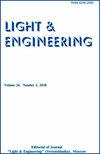考虑光的破坏性影响的展览照明设计
IF 0.3
4区 工程技术
Q4 ENGINEERING, ELECTRICAL & ELECTRONIC
引用次数: 0
摘要
博物馆展览照明设计的一个重要问题是在提供良好的展品可视性和保护它们免受破坏性光影响之间找到平衡。本文介绍了作为国家冬宫博物馆达芬奇大厅照明设计的一部分进行的研究。它是基于对在照明审核过程中收集的数据的分析、对现有的采光和电气照明进行建模,并将这些活动的结果与适用的博物馆照明法规的要求进行比较。研究结果包括对大厅现有照明系统的缺点的确凿结论,以及照明装置现代化的设计解决方案,建议调整采光和电气照明的数量和色度,并附有布置和瞄准图,以及照明设备的规格。研究表明,满足展品的标准化垂直照度要求并不能保证总暴露在日光和电力照明下不超过其保存所允许的限制。分析指出了这一问题,这一问题适用于大多数博物馆和画廊,并开发了该大厅的照明设计,为它提供了一个简单而经济的解决方案。本文章由计算机程序翻译,如有差异,请以英文原文为准。
Design of Exhibition Lighting Considering Damaging Impact of Light
An important problem of museum exhibition lighting design is finding a balance between illumination conditions providing good visibility of exhibits and preserving them from damaging light impact. The article presents the study conducted as part of design of lighting for the Leonardo da Vinci Hall in the State Hermitage Museum. It is based on analysis of the data collected during lighting audit, modelling of the existing daylighting and electric lighting and comparison of the results of these activities with requirements of the applicable museum illumination regulations. The results of the study contain the substantiated conclusions on disadvantages of the existing lighting system of the hall and the design solution for modernisation of the lighting installation with recommendations for adjustment of the amount and chromaticity of daylighting and electric lighting, with the diagram of arrangement and aiming, and with the specification of lighting equipment. The study demonstrates that meeting the requirements to standardised vertical illuminance on exhibits does not guarantee that total exposure to daylighting and electric lighting does not exceed the limit allowable for their preservation. The analysis points out this problem, which is applicable to most of museums and galleries, and the developed lighting design for the said hall demonstrates a simple and affordable solution of it.
求助全文
通过发布文献求助,成功后即可免费获取论文全文。
去求助
来源期刊

Light & Engineering
ENGINEERING, ELECTRICAL & ELECTRONIC-OPTICS
CiteScore
1.00
自引率
50.00%
发文量
0
审稿时长
1 months
期刊介绍:
Our magazine
develops comprehensive communication within the lighting community, providing opportunities for discussion and free expression of opinions of specialists of different profiles;
contributes to the convergence of science and engineering practice, the search for opportunities for the application of research results in lighting and technological applications of light;
keeps the scientific community up to date with the latest advances in the theory of the light field, providing readers with operational professional information;
initiates international cooperation, promotes and distributes the results of Russian authors in the international professional community;
provides equal opportunities for authors from different regions of Russia and other countries.
The journal publishes articles in the following areas:
visual and non-visual effects of radiation on humans;
light field theory;
photometry and colorimetry;
sources of light;
ballasts;
light devices, their design and production technology;
lighting and irradiation installation;
light signaling;
methods of mathematical modeling of light devices and installations;
problems of energy saving in lighting, installation and operation of lighting installations;
modern production technologies of lighting products for lighting control systems;
innovative design solutions;
innovations in lighting and lighting design;
the study of the effect on plants and animals, problems of using light in medicine;
problems of disinfection of premises, water and smell elimination with the help of technology of UV radiation using;
problems of light in the ocean and space.
 求助内容:
求助内容: 应助结果提醒方式:
应助结果提醒方式:


